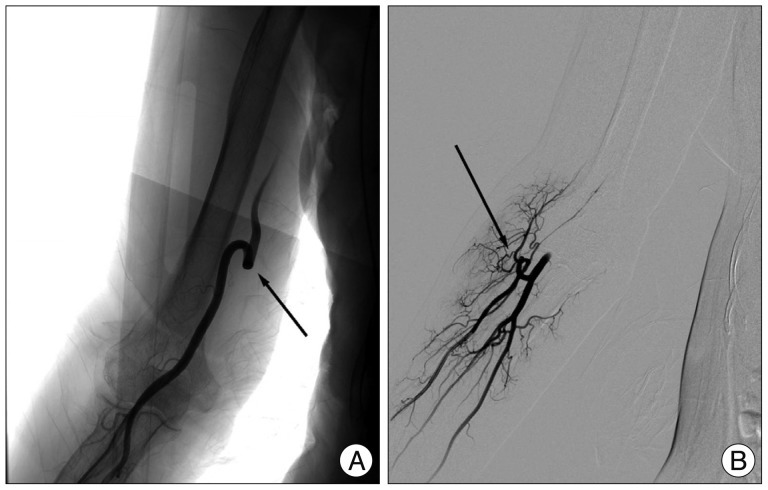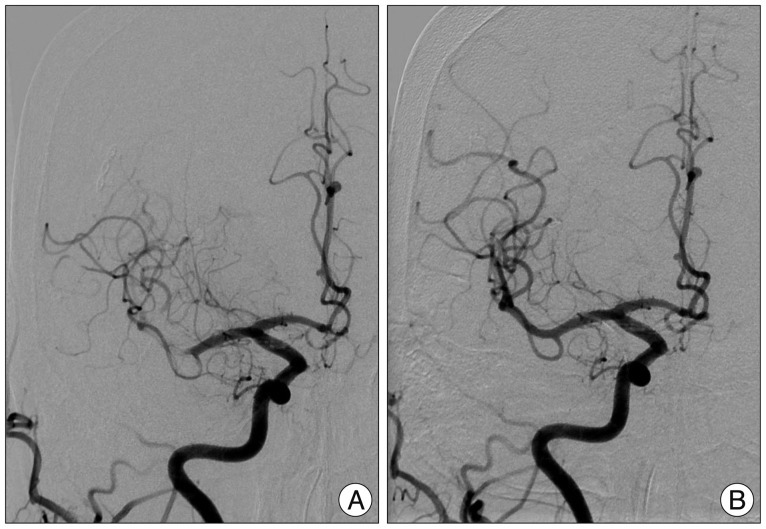J Korean Neurosurg Soc.
2013 Apr;53(4):213-217. 10.3340/jkns.2013.53.4.213.
Efficacy of Transradial Cerebral Angiography in the Elderly
- Affiliations
-
- 1Department of Neurosurgery, Gospel Hospital, Kosin University College of Medicine, Busan, Korea. peiothmd@daum.net
- KMID: 1426206
- DOI: http://doi.org/10.3340/jkns.2013.53.4.213
Abstract
OBJECTIVE
Transradial angiography has become popular among many cardiologists as a diagnostic and therapeutic tool. However, transradial cerebral angiography is not utilized to the same extent. The purpose of this study is to present our experience regarding the usefulness of transradial cerebral angiography, especially in elderly patients.
METHODS
Between May 2011 and February 2012, a total of 126 cerebral angiographies were performed via a transradial approach in a single center. Of them, only 47 patients were over 60 years old. In our institution, we shifted the initial access from the right femoral artery to the right radial artery in all patients requiring cerebral angiography in 2011. We did not attempt radial access in 40 cases for variable reasons.
RESULTS
The procedural success rate was 92.2%. We have four failures of transradial angiography; two because of loop formations of the radial and brachial artery and two due to multiple puncture failures. All supra-aortic vessels were successfully catheterized. However, the selective catheterization rates of the left side distal vessels were lower, as success rates were 89.7% for the right internal carotid artery and 75% for the left internal carotid artery. Procedure-related vascular complications, such as puncture site hematoma, hand ischemia, pseudoaneurysm, arteriovenous fistula and arterial dissection were not observed in our series. However, intraprocedural thrombosis developed in one patient, which was resolved completely by intraarterial thrombolytic agents.
CONCLUSION
With advancing patient's age, we believe that transradial cerebral angiography is a useful tool to decrease patient's discomfort and more effectively manage the vessel tortuosity.
Keyword
MeSH Terms
Figure
Cited by 1 articles
-
Complications and risk factors after digital subtraction angiography: 1-year single-center study
Ho Hyun Nam, Dong Kyu Jang, Byung Rae Cho
J Cerebrovasc Endovasc Neurosurg. 2022;24(4):335-340. doi: 10.7461/jcen.2022.E2022.05.001.
Reference
-
1. Bendok BR, Przybylo JH, Parkinson R, Hu Y, Awad IA, Batjer HH. Neuroendovascular interventions for intracranial posterior circulation disease via the transradial approach : technical case report. Neurosurgery. 2005; 56:E626. discussion E626. PMID: 15730593.2. Campeau L. Percutaneous radial artery approach for coronary angiography. Cathet Cardiovasc Diagn. 1989; 16:3–7. PMID: 2912567.
Article3. Fessler RD, Wakhloo AK, Lanzino G, Guterman LR, Hopkins LN. Transradial approach for vertebral artery stenting : technical case report. Neurosurgery. 2000; 46:1524–1527. discussion 1527-1528. PMID: 10834658.4. Heiserman JE, Dean BL, Hodak JA, Flom RA, Bird CR, Drayer BP, et al. Neurologic complications of cerebral angiography. AJNR Am J Neuroradiol. 1994; 15:1401–1407. discussion 1408-1411. PMID: 7985557.5. Hildick-Smith DJ, Walsh JT, Lowe MD, Shapiro LM, Petch MC. Transradial coronary angiography in patients with contraindications to the femoral approach : an analysis of 500 cases. Catheter Cardiovasc Interv. 2004; 61:60–66. PMID: 14696161.
Article6. Iwasaki S, Yokoyama K, Takayama K, Ueda K, Sueyosi S, Nagasawa M, et al. The transradial approach for selective carotid and vertebral angiography. Acta Radiol. 2002; 43:549–555. PMID: 12485248.
Article7. Jo KW, Park SM, Kim SD, Kim SR, Baik MW, Kim YW. Is Transradial Cerebral Angiography Feasible and Safe? A Single Center's Experience. J Korean Neurosurg Soc. 2010; 47:332–337. PMID: 20539791.
Article8. Kiemeneij F, Laarman GJ. Transradial artery Palmaz-Schatz coronary stent implantation : results of a single-center feasibility study. Am Heart J. 1995; 130:14–21. PMID: 7611104.
Article9. Kiemeneij F, Laarman GJ, Odekerken D, Slagboom T, van der Wieken R. A randomized comparison of percutaneous transluminal coronary angioplasty by the radial, brachial and femoral approaches : the access study. J Am Coll Cardiol. 1997; 29:1269–1275. PMID: 9137223.
Article10. Kim JH, Park YS, Chung CG, Park KS, Chung DJ, Kim HJ. Feasibility and utility of transradial cerebral angiography : experience during the learning period. Korean J Radiol. 2006; 7:7–13. PMID: 16549950.
Article11. Laarman G, Muthusamy TS, Swart H, Westendorp I, Kiemeneij F, Slagboom T, et al. Direct coronary stent implantation : safety, feasibility, and predictors of success of the strategy of direct coronary stent implantation. Catheter Cardiovasc Interv. 2001; 52:443–448. PMID: 11285596.
Article12. Lee DH, Ahn JH, Jeong SS, Eo KS, Park MS. Routine transradial access for conventional cerebral angiography : a single operator's experience of its feasibility and safety. Br J Radiol. 2004; 77:831–838. PMID: 15482994.
Article13. Levy EI, Boulos AS, Fessler RD, Bendok BR, Ringer AJ, Kim SH, et al. Transradial cerebral angiography : an alternative route. Neurosurgery. 2002; 51:335–340. discussion 340-342. PMID: 12182771.
Article14. Matsumoto Y, Hokama M, Nagashima H, Orz Y, Toriyama T, Hongo K, et al. Transradial approach for selective cerebral angiography : technical note. Neurol Res. 2000; 22:605–608. PMID: 11045024.15. Matsumoto Y, Hongo K, Toriyama T, Nagashima H, Kobayashi S. Transradial approach for diagnostic selective cerebral angiography : results of a consecutive series of 166 cases. AJNR Am J Neuroradiol. 2001; 22:704–708. PMID: 11290482.16. Moran CJ, Milburn JM, Cross DT 3rd, Derdeyn CP, Dobbie TK, Littenberg B. Randomized controlled trial of sheaths in diagnostic neuroangiography. Radiology. 2001; 218:183–187. PMID: 11152799.
Article17. Nohara AM, Kallmes DF. Transradial cerebral angiography : technique and outcomes. AJNR Am J Neuroradiol. 2003; 24:1247–1250. PMID: 12812964.18. Park SH, Park JC, Hwang JH, Hwang SK, Hamm IS. Role of three-dimensional computed tomography angiography in the follow-up of patients with aneurysm clips. J Korean Neurosurg Soc. 2006; 39:427–431.
- Full Text Links
- Actions
-
Cited
- CITED
-
- Close
- Share
- Similar articles
-
- Percutaneous Transradial Approach for Coronary Angiography
- Is Transradial Cerebral Angiography Feasible and Safe? A Single Center's Experience
- Feasibility and Problems in Transradial Coronary Angiography and Intervention
- The Safety and Feasibility of Transradial Coronary Angiography Over 70-Year-Old Patients
- Transradial Approach for Neurovascular Interventions : A Literature Review



